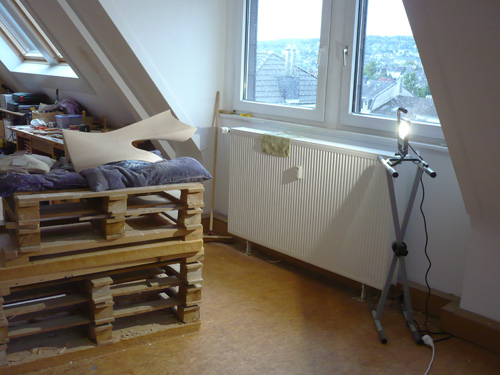maple, 2018
day 1
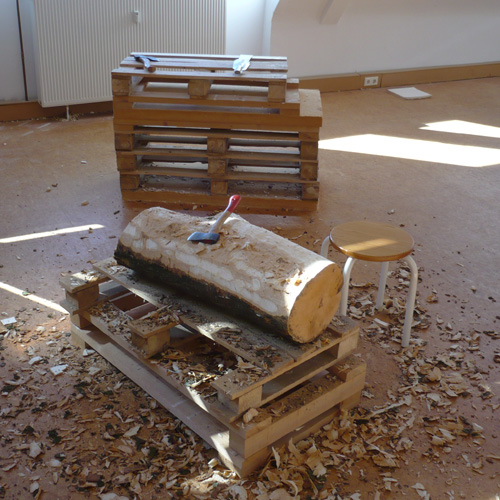 Usually I don’t sit down working on a piece. But this one was simply too heavy to get it up onto the platform all the way. So getting the bark off is the first step to enlightenment :-)!
Usually I don’t sit down working on a piece. But this one was simply too heavy to get it up onto the platform all the way. So getting the bark off is the first step to enlightenment :-)!
And this is very fresh and its maple. So it allows me to get the hatchet between the bark and the hard wood of the stem and peel it away clean. This results in a very smooth surface that feels physical and naked as a representation of this piece of wood. It gives me an immediate feeling of who this is in front of me: the strength, the movement of it. Like muscles under the skin. It makes it easier to understand the direction in which I’m going to develop it.
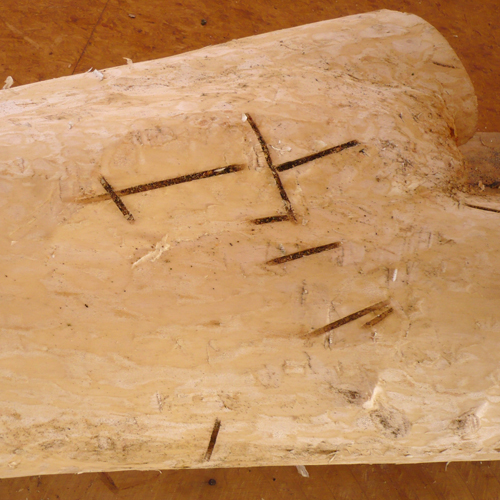 One overall gesture stands out: these broad muscle cords on both sides of the branch and a thinning main stem towards the other side. That’s where I’m going to start. But first: There are a few cuts from the power saws at one side. I’d like to smooth them because I fear they might trigger cracks in those places where they are in line with the fibres. Cracks are usually unavoidable. But I can at least minimize the risk.
One overall gesture stands out: these broad muscle cords on both sides of the branch and a thinning main stem towards the other side. That’s where I’m going to start. But first: There are a few cuts from the power saws at one side. I’d like to smooth them because I fear they might trigger cracks in those places where they are in line with the fibres. Cracks are usually unavoidable. But I can at least minimize the risk.
I think I’ll be working sitting on that stool for a while, until the piece is dry and slim, and thus light enough to be moved onto the platform.
Got it!
Couldn’t leave it alone. The thing is: sitting on a stool inhibits me. It ties me to one spot while I’d like to move around, especially when working with the hatchet. So I thought it through once more: The platform could be lowered by one element. Because the piece is so big it would still be high enough to work comfortably. This element I step by step inserted into the existing lower platform with the piece on it. – It is sometimes an advantage that I can push things across this wooden floor. But sometimes you don’t want things to move but to stay put. Tricky! I had to prop the lower platform against the wall to push the new element in between. And then I could push it over to the higher platform to make the transition. – So the distance between higher and lower platform was reduced considerably and enough to make it work. Though sometimes I’d love to have a crane…
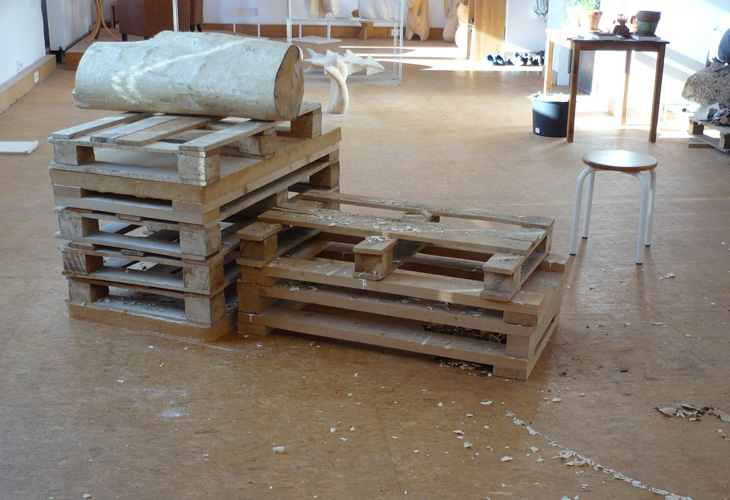
Okay, I have an image for this one and I go with it. Having this abundance of wood, I can experiment. Also: This is something different from my usual form language. Let’s see.
Some surprises waiting for me in the branch fork. So far just a discoloration. What it really is and how deep it goes remains to bee seen. I wanted to go in there anyway.
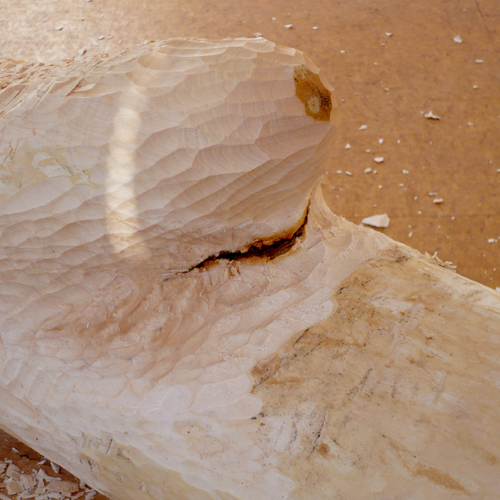
first look
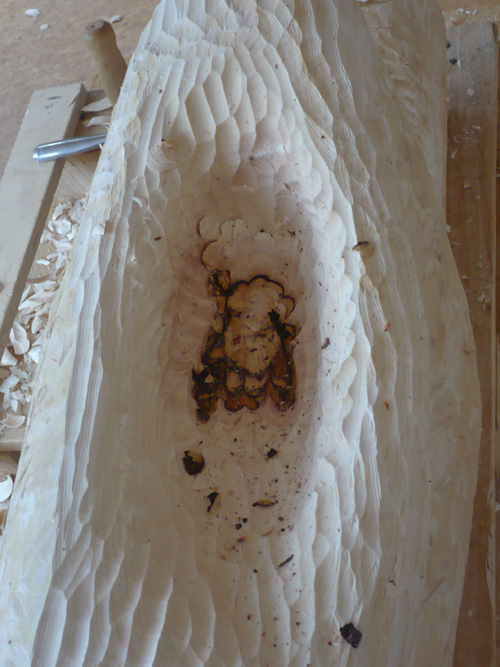
it goes deeper
And yes, I know, it looks like an early state of connection (see process after one day) . But the image in my head is very different.
I knew I overdid it and so I’ll pay for it. But it was absolutely worth the thrill! Its interesting how one can feel so sore and so happy at the same time.
day 2
The vision changed during the night somewhere around 4 am. Changed and became more concrete from just a motive to a fully spelled out form. By 5 am I had even more ideas. Not sure yet which of them I’m going to realize.
Another idea came right along for the piece of beech I acquired the same day as this maple. More naturalistic than anything I’ve ever done. But as I said: time to experiment.
There wasn’t much sleep with all these ideas and inspiration vibrating through and all around me. I would have loved to get up and start with them. But there are people living in this house. And I also needed some rest after the tour de force yesterday.
day 3
Got a lot of work done yesterday but still so far to go! The vision changes and refines itself continuously. It’s a constant flow of ideas and images that can be exhausting or exhilarating depending on whether you want to work or rest/sleep. I’m still within the limits of those images, so no major decisions needed other than to continue with that vision. But its not like painting by numbers. There is so much to find out during the process. Especially how the transition between one surface / movement to another – often to its opposite – works. That’s one of the tricky parts: the transition between convex and concave. And this sculpture has it in spades!
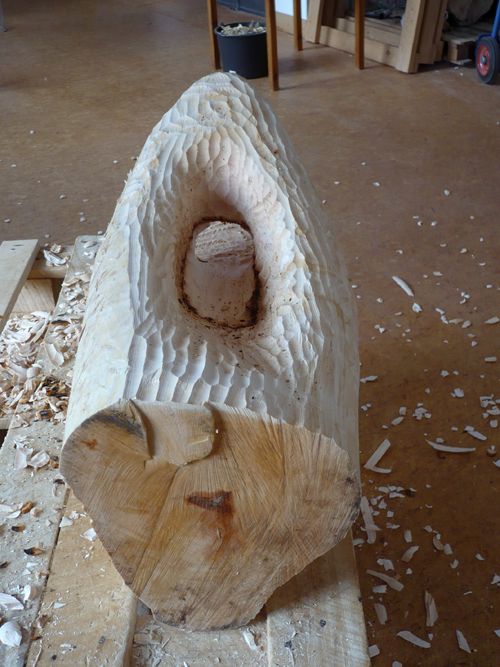 I start to refine the ‘head’ quite early on. Those ends are the hardest parts of the wood and easier to work on while still wet. So I try to get it out of the way as much as possible. Actually it looks a bit like a mix between Hamburgs Elbphilharmonie and Wolverines hairstyle. Hmmm, been watching too many X-men movies lately?. Got to fix that – the head not the movies.
I start to refine the ‘head’ quite early on. Those ends are the hardest parts of the wood and easier to work on while still wet. So I try to get it out of the way as much as possible. Actually it looks a bit like a mix between Hamburgs Elbphilharmonie and Wolverines hairstyle. Hmmm, been watching too many X-men movies lately?. Got to fix that – the head not the movies.
I also switched to the gouge and mallet quite early on. Partly because I’m relatively sure where I want to go with this. And the gouge gives me more control. And there is also the fear that the impact of the hatchet might lead to cracks or breaking, which obviously I’m trying to avoid. The other strategy to prevent cracks is to go in deep at the sides so the stem can dry there. And making that breakthrough in the branch yesterday that hopefully stabilizes that arch, even though there is this rotten stripe in it.
day 4
I have to test some of the images that went through my mind in the evening and during the night. There is always a difference between the inner image and the hard reality of the wood. Sometimes I can make it work in the wood, sometimes I have to change the vision.
It gets a little more ‘brainy’ and less intuitive the thinner the piece becomes. The advantage is: I can now carry it! The disadvantage is: it becomes more fragile – if you can call this chunk of wood that – and I have to be careful where an how I use force on the piece. Sliming down all the parts step by step and then at some point use the cushions to dampen the impact of the hits and distribute it over a larger part of the surface instead of just where the piece touches the platform.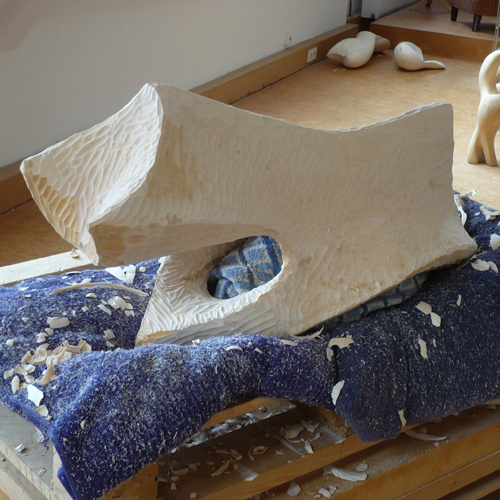
This one is at risk of breaking due to the rotten layer of wood that had developed between stem and branch. Yes it was more than just a discoloration. It goes deep and gets broader the deeper I went into that branch fork. I guess it is the result of leaves and water (rain) collected in the branch fork and seeping into the wood that over the years caused this rotten area. And the tree just covered it with fresh wood as it grew. Maybe that’s the reason for what I perceived as those ‘muscle cords’ in the beginning. I need to take this into account as well while shaping the different parts.
day 5
The experience with this one is – more that with many other pieces – one of continuously destroying my own work. I know I’m quite far, but there is still a long way to go. Thus whatever I have done so far will be gone in the end.
Yes! That was a good decision: transforming a convex surface into a concave one. A lot of stuff to loose. One side is done, the other still waiting.
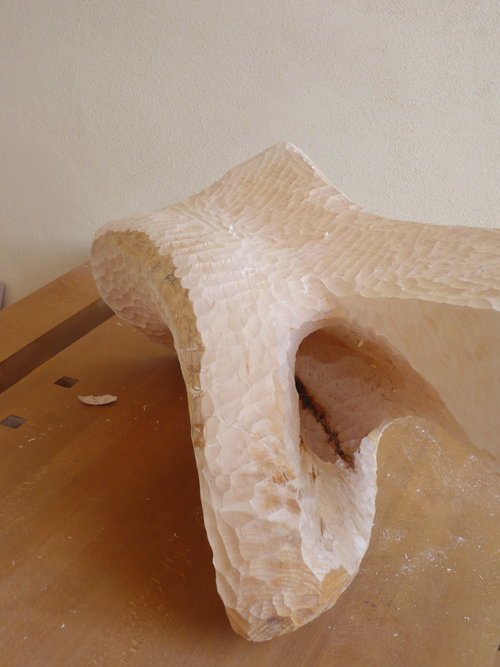
convex
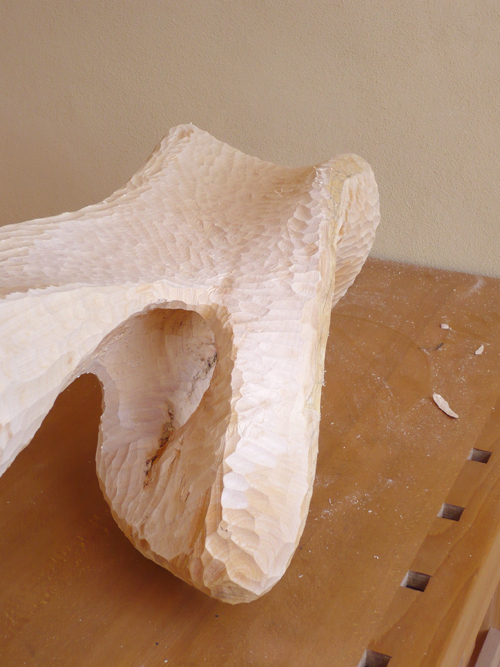
concave
Air creature – Luftwesen?
The vision certainly would fit that bill. But can I get there? Where are the limits of the material? I’m getting more an more cautious for fear of breakage. That leads to tension (in the body) which is not helpful.
day 6
The changes I made in the morning were obvious. More refining than changing. But now its about decisions again. Some of what I see, I like, and some I don’t. And that’s not about the sculpture having a good side and a bad one. There are some things that don’t really fit. The problem is that I don’t know which ones or where to go with them. If two parts don’t fit together you can change one or the other or both.
Possible next steps:
– let it rest for a while
– work over it with the rasp (is it already dry enough?)
– sketching it to get a better understanding
All good ideas. So what to do first?
several days later
I did let it rest for half a day. Now I’m working on it with the rasp. Its not yet really dry, but enough to smooth out the main bumps and better understand the surfaces. But its hard on the hands. So it takes time because I have to pause a lot.
I have some ideas, where to go deeper. But for now I restrain myself from doing so and just smooth it. (And take the time to put this stuff online…)
Working on a sculpture of which I see and feel that it is not right and not changing it is frustrating. This is not a good place to be in with all those unsolved questions hanging in the air. But taking action just because I can’t stand the stagnation is something I might regret later. This is about finding the difficult balance between my internal need to make the vision come true and the practical need to understand both the vision and the wood to be able to make it come true. Impatience can lead to mistakes – if one can call them that – but action without checking everything twice can lead to discoveries that otherwise wouldn’t happen because they cannot be planned.
Holding myself in check action wise while seeing options for such action all the time increases the tension. And the rasping takes so much time!
dried – at least much more
After the completed rasp surface I let it rest and worked on decision in the meantime. This time gone by confirmed the changes I had in mind already before that break. They were made quickly.
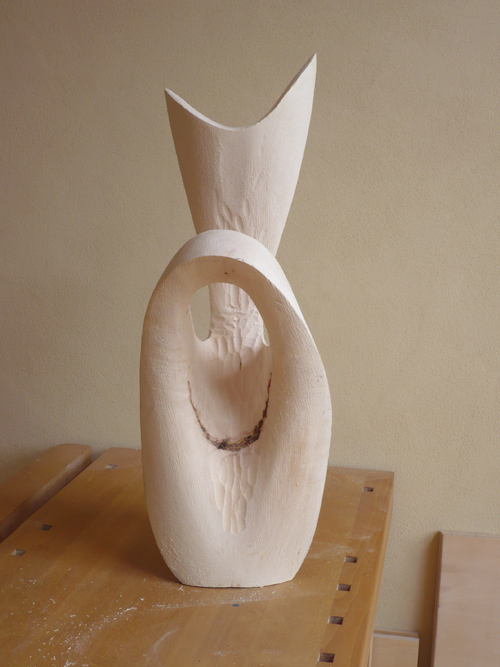
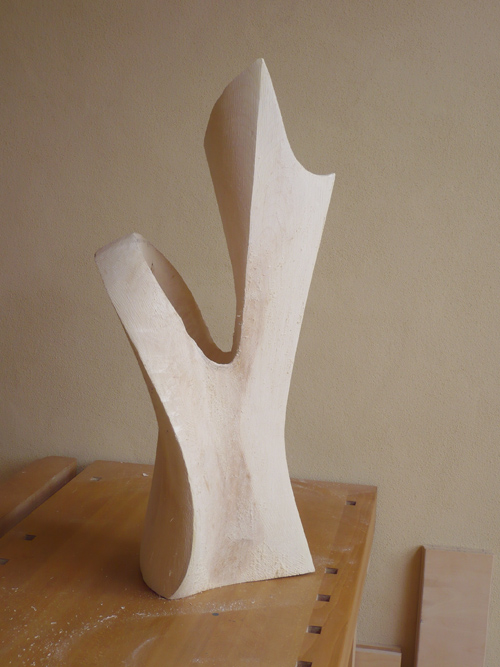
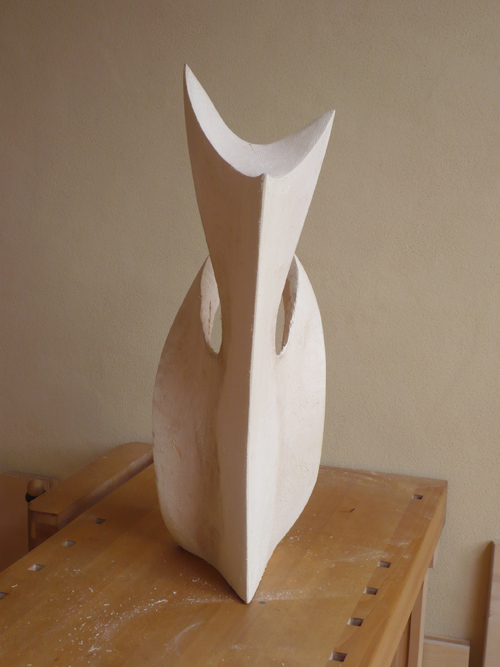 And the result felt much better than before. I was stuck with this one, nearly on the wrong track from which there was no coming back. Now its opening up again. The critical issue now is still to avoid breakage. It will get rather thin in certain areas. Cushions, cushions, cushions! And working slow, small chips, applying only a little pressure with each hit as well as with the rasp. It takes time but its coming along.
And the result felt much better than before. I was stuck with this one, nearly on the wrong track from which there was no coming back. Now its opening up again. The critical issue now is still to avoid breakage. It will get rather thin in certain areas. Cushions, cushions, cushions! And working slow, small chips, applying only a little pressure with each hit as well as with the rasp. It takes time but its coming along.
I thought I was there and started fine-tuning with the fine rasp. But I still felt uneasy about the front part. It doesn’t really work. And that is not (only) because of the rotten part there. I had a vision of opening it up completely. But I don’t think that would work either. But I took the gouge and went in much deeper.

Looking at it that way revealed another ‘flaw’. I generally like it when the piece is not symmetrical but slightly twisted. But there is a twist at both the basis and the top of the oval. And that’s a bit much, mostly because there is no real motivation for the twist. So more adjustments there.
Still not sure about the whole thing! Should I dare realizing what I see in my vision? Will it break? I could finish the outside first, so I don’t have to put pressure on it any more and then open up the middle. That means working for a long time on the part that works and leaving the part that doesn’t hanging there. I definitely don’t like that outlook. And there is no way of testing it. Okay, lets fix those twists first.
If this is the one where I fail, so be it! It has to happen someday, I guess. Well I did fail twice before, but that was with smaller pieces that were more of an experiment anyway with high probability of failure. This would be different. Quite early on this piece felt as if it won’t work out. There is a German word ‘stimmig’ which in this case could be translated as ‘in tune’. This piece is not in tune with itself, or at least the front is not in tune with the rest. And I want to get there. I might not be able to, either because I break it along the way or it is not in there any more – in what is left of the stem. Or is it my visions that are out of tune with the wood? Can’t figure it out – yet.
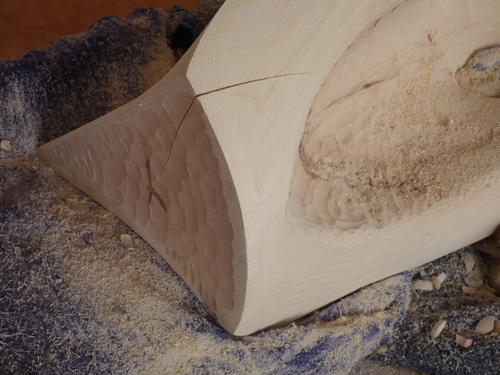 This piece is making decisions for me. We had a sudden swing in weather and after a cold period and frost now, after Easter, temperatures are going up above 20° C. I was sitting in a corner of the workshop, reading, when I heard a loud crack. I went to the platform and discovered a crack at the bottom of the sculpture. During the next day, several more appeared. They are marking the margins of the sides of the opening I have in mind. What I originally saw there would not hold any more. The cracks deleted that possibility.
This piece is making decisions for me. We had a sudden swing in weather and after a cold period and frost now, after Easter, temperatures are going up above 20° C. I was sitting in a corner of the workshop, reading, when I heard a loud crack. I went to the platform and discovered a crack at the bottom of the sculpture. During the next day, several more appeared. They are marking the margins of the sides of the opening I have in mind. What I originally saw there would not hold any more. The cracks deleted that possibility.
Its funny that cracks appear there, because I went quite thin with the whole piece and came close to the core. But obviously there is still enough tension in the drying process, especially when it goes on so fast. It makes the finalizing of this part of the sculpture even more suspenseful. But still I have to smooth the sides first. These surfaces are so complex, as I found out while starting to work on them with the sand paper, that I had to work over them completely with the rasp again.
June
Started again. I wonder if I waited too long! It’s bone dry and very hard. I have to adjust my working style to the different condition of the wood, taking off smaller portions using a different gouge. It took a while to find the right tools and the right angle. I’m pretty sure where I want to end up in terms of the thickness of the sides – the cracks give me a good measure of that – but the form still has to work in the inside. And I have to lay the ground for that form from the start. High energy. I’m jittery, looking forward to finally do this, but also fearful. I think a little calmer mood would be better. As so often this is about trust.
I guess I had an image of me opening the basis of the sculpture within a few hours in one go. Maybe that’s why it was so scary. Its easier – mentally – when I can take my time with it and slowly, step by step work towards a result.
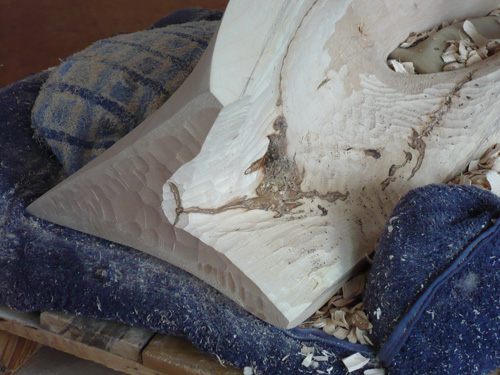
July
But it’s the opposite of my fears. It goes on for weeks and that gets frustrating. Here a bit of change, that raises a new problem. Another bit of change that raises a problem elsewhere, and so on. I try to understand it, construct a solution. I thought I understood it, but fortunately I’m careful enough to take it one step at a time. Switching from gouge to rasp, to gouge, to rasp to fine rasp and back. And then suddenly it feels right under the palm of my hand stroking over the surface. It suddenly works. And I’m not even sure why. Lets see if it still works when I do the other side.
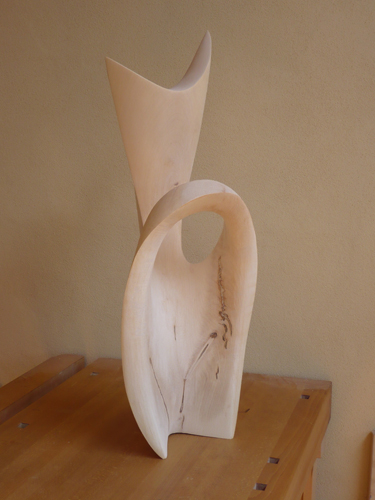 Its pretty far now and it works. But I don’t know it this is far enough. I can’t see it any more after so much detail work. So I put it aside and let it rest for a while, while I finalize some of the others. Chronological order seems to be a good idea, so hand it is.
Its pretty far now and it works. But I don’t know it this is far enough. I can’t see it any more after so much detail work. So I put it aside and let it rest for a while, while I finalize some of the others. Chronological order seems to be a good idea, so hand it is.
2019
I had a feeling that this one was not where it should be. And after the break it becomes even more obvious. I could chicken out and let it be. But I, at least, would always know, that its not finished. But before I thin the sides any further from the inside, I finish the outside surface of the whole piece, so that there will be no pressure from those areas. Boring… just grinding out the scratches. But maybe boring is what I need at the moment.
September/October
After giving it some rest I made the sides of the front part even thinner. They still didn’t feel right after the first go. This meant working out the whole inside part of the front again. And that was always a tricky one. Finally it felt right.
And that started the tedious process of working over the whole sculpture again to get rid of the scratches from the rasps and file that were still left. Switching between different grades of sand paper and often needing my glasses to be sure it was done… With the start of fall and dwindling light I needed the help of artificial light coming in at a sideways angle to be able to see the last scratches. It is amazing how many I find. An important investment this LED spotlight, but a tricky one.
